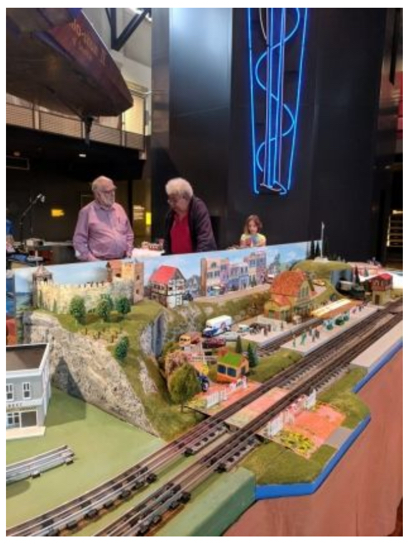By Ed Ives
“Write a piece for the Grab Iron on the construction of layout modules”, they said, like there was only one. Each modular group in 4D have their own module standards and there is at last count five modular groups in 4D; two N gauge; one HO, one On30 and the O gauge Hi-Railer’s. I’m with the latter.
Why modular? – Modular layouts are a way of attending events, in plain view of the public, displaying our craft and hopefully encouraging new membership. This is something your very fine layout in the basement has difficulty doing. Within as little as four weeks you could have a basic module suitable for using at the next train show. The module can be transported in the trunk of the average car or the back of an SUV with plenty of room to bring you favorite trains to run. The added benefit is you’ll make friends both within your group and between groups. It can be a very social activity.
The ‘basic’ Hi-Rail module is a table 50 inches wide, 30 inches deep and a nominal 36 inches height with +/- 1″ adjustment. The table top is made of 1 x 4’s on edge for all four sides. The top is plywood 5 mm thick or upwards. Remember the thicker the plywood, the heavier this thing gets. The table sits on four legs, one close to each corner. The legs, either 1 x 2 or 2 x 2 wood may be permanently attached with locking hinges or removeable set in sockets. I prefer the former as you can’t get the, ‘Oh Gosh’ moment on set up at a show realizing that you brought the module and left the legs at home. This would not have been the first time for this to happen. The aim is that any module may connect to any other module using standard ‘C’ clamps.
Track – We use the O gauge tubular (not O27) or Gargrave’s flex track set on cork roadbed 4 inches and 7 1/2 inches in from the front edge in the table for a double track. The track and roadbed to terminate 5 inches in from each end. Ballasting the track is a teaser. One can use the commercial packets of O gaugeballast and buy several packets or an alternative. We use the latter; roofing grit, the stuff they use on wet tar roofing. It comes in a variety of colors. I bought some grey which in the event was more blue than grey. The ‘group’ was highly critical of this ‘grey’ so I have the best part of 100 pounds of this stuff to lose, somewhere. The second choice was builder’s sand, not play sand, screened using an old flour sieve. This yields a nice quantity of suitable gravel but makes for a heavy module. Remember, these modules are mobile and have to be lifted and carried. The last try is to use ground walnut shells as used for grit blasting paint removal. The color and size is good but the drawback is the minimum quantity to buy is 100 pounds. I’ve used this stuff for a good fifteen years and still have three quarters of it left. If you speak to me nicely I’ll let you have some.
Electrically we use two power busses, one for each track. Color coding the wiring is imperative. Since we use three rail track, a red 14 AWG feeder wire is used for the center rail of the outside track; yellow 14 AWG wire for the center rail of the inside track and all running rails to have white 14 AWG feeder wires. Power drops from the rails to the feeder to also be color coded the same as the feeders and be 16 AWG. All wiring to be stranded. Modules are electrically connected together using rectangular six pin trailer plugs.

Scenery is your choice and shall be complete within your module or modules if you produce more than one.
NOW THE WARNING LABEL – Belonging to a module group is addictive (and fun).
Like most things module building can get out of hand. I started with one locomotive and ten freight cars with a need to run someplace other than on track on the living room floor. I could easily transport this all in a cardboard box. I started with one module carried in the trunk of the car, then needing a truck, then a trailer behind the truck, then a full size van to pull the trailer. All this because I now have at last count 26 mostly customized modules for specific use, more in various stages of build and of course numerous trains.
There should be a MA group, Modules Anonymous.
Ed Ives

No Comments Yet